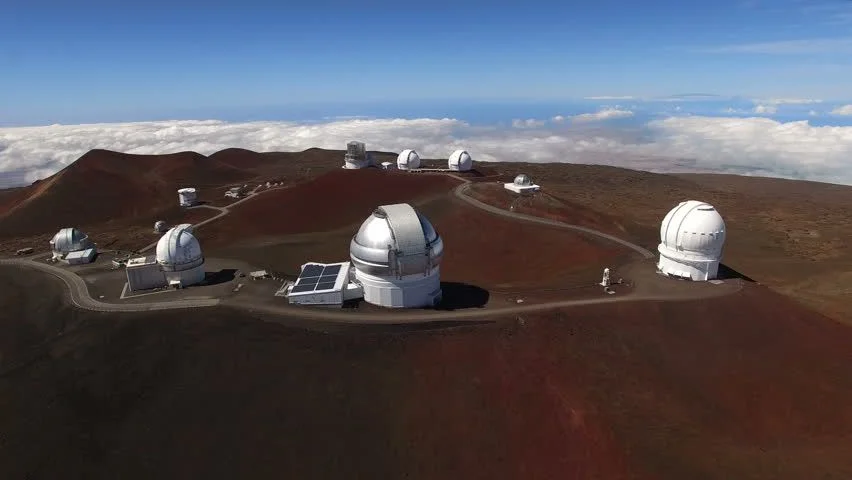Mauna Kea, Hawaii
In my last blog, I described my recent trip to the observatories on Mauna Kea, Hawaii.
The mountain, a dormant volcano, is home to the highest concentration of great telescopes on Earth.

Mauna Kea, Big Island, Hawaii. Photo:International Gemini Observatory/NOIRLab/NSF/AURA/J. Chu
Now we’ll explore some of these great observatories and look at their discoveries.
Astronomy heaven
Hawaii is often described as an earthly paradise.
It certainly is a wonderful place to visit – and to live.
The climate, the people and the stunning landscapes are simply enchanting.
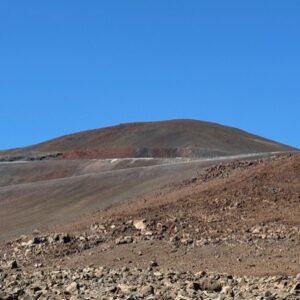
The summit of Mauna Kea, Photo: Dennis Ashton
For astronomers, Mauna Kea is literally heavenly.
The 14,000 foot peak offers the clearest air and darkest skies.
It is an ideal place for large professional telescopes.
Objections to the observatories
Mauna Kea summit has strong cultural and religious significance for Hawaiins.
Not everyone is in favour of having observatories in this sacred place.
Up to now, the objections have not stopped the building of new facilities.
However a new authority is now in charge of developments at the summit.
It includes both the University of Hawaii and local residents.
How that plays out, we’ll have to wait and see.
The Observatories
In total, their are ten active facilities spread around the summit.
They house some of the world’s largest telescopes.

Observatories of Mauna Kea: Goodfreephotos.com
I’ll describe three observatories of greatest interest to me.
You can find a full list and details of more at Mauna Kea Observatories.
Subaru
Most people will associate this name with a Japanese car maker.
And indeed, the Mauna Kea telescope is run by the National Astronomical Observatory of Japan.
In astronomical terms, Subaru is the Seven Sisters star cluster, the Pleiades.
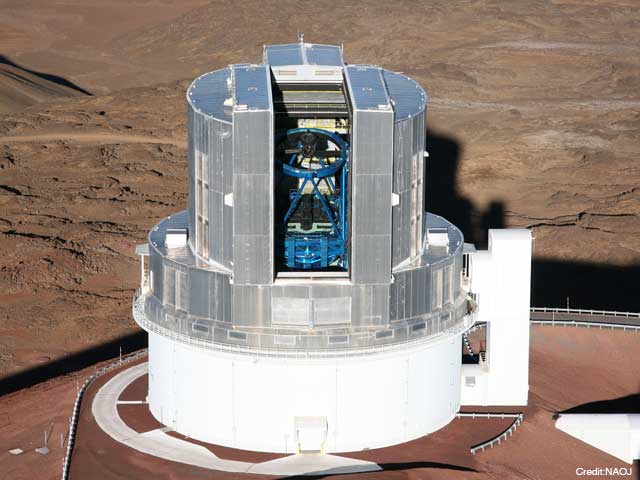
Subaru Observatory: National Observatory of Japan, NAOJ
The silver building houses a giant telescope with an 8.2 metre mirror.
Beneath the mirror are 262 actuators which can delicately change its curvature.
This, combined with adaptive optics we’ll mention later, make its focus absolutely precise.
Ten cameras and other instruments assist a large variety of observing projects.

Subaru Telescope. Credit: Kazuhito Dobashi/NAOJ
The wide field of view makes the Subaru Telescope ideal for sky surveys.
One of its current projects is the search for Planet 9.
This is a suspected large planet hidden in our Solar System somewhere beyond Neptune.
From Subaru you can see the sky at night on Mauna Kea.
A webcam gives live views, well worth a look.
Keck
On the same summit ridge as Subaru stand the two Keck Observatory domes.

Subaru and Keck Observatories. Photo: Dennis Ashton
Each dome contains a telescope with a 10-metre mirror.
When they were completed in 1996, they were the largest in the world.
They remain third largest to this day.

Keck mirror: W M Keck Observatory
Each mirror is made of 36 hexagonal segments.
Each segment is 1.8 metres wide, 7.5cm thick and weighs half a ton.
The alignment of the segments can be tweaked to give sharp focus.
The observatory is run jointly by Caltech, the University of California and the University of Hawaii.
Much of its telescope time is devoted to deep space projects.
Distant galaxies, quasars , galaxy clusters are all objects scrutinised by astronomers using the two Keck telescopes.
Other projects involve exoplanets, planets orbiting distant stars in our own galaxy.
One of Keck’s major discoveries was that the universe is expanding at an increasing rate.
This lead to the concept of dark energy as a major component of the universe.
Nearer to home, Keck also gave us the first photo of exoplanets.
The image showed three planets, marked a, b and c, orbiting a star some 140 light years away.
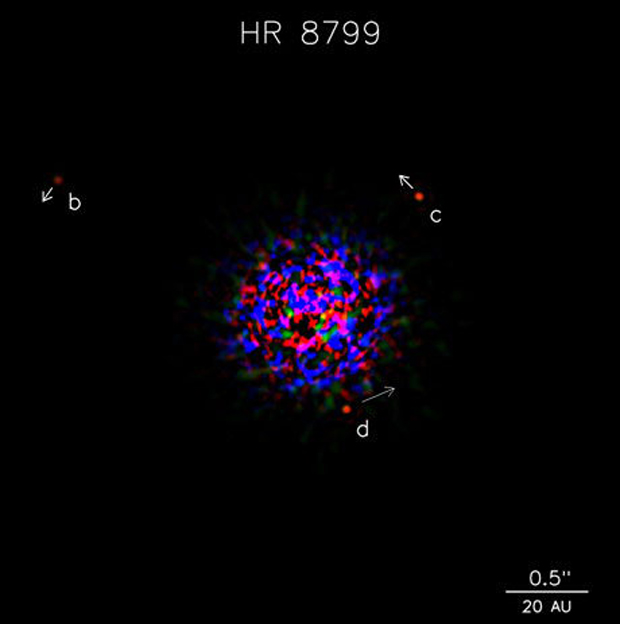
Exoplanets orbiting star HD8799: Keck Observatory
This kind of imagery is difficult because the star far outshines its orbiting planets.
It’s like trying to see a candle flame next to a searchlight.
But the two Kecks did it.
Gemini North
My third observatory is Gemini North.
As its name implies, Gemini has a twin.
But unlike the Kecks, the twin is not alongside on Mauna Kea.
Gemini South is located at Cerro Tolollo in Chile.

Gemini North Observatory. Photo: Dennis Ashton
USA’s national Science Foundation is the main funder of Gemini though other countries are involved.
They include Chile, Brazil, Argentina, Canada and Korea.
Each Gemini has a telescope with an 8.1 metre mirror.
Gemini North saw first light in 1999.
Gemini South followed a year later.
The range of Gemini projects covers the cosmos, from our Solar System and exoplanets to deep space.
Star formation, black holes, quasars, galaxy structure and more have come under the scrutiny of these powerful instruments.
The Gemini telescopes are in the forefront of adaptive optics.
We’ll take a look at this technique which allows giant telescopes to focus precisely on distant objects.
Adaptive Optics
The Earth’s atmosphere is turbulent.
High level winds and different temperature zones disturb the air.
That disturbance distorts the view through telescopes.
It’s the reason that stars appear to twinkle.
It even affects the crystal clear air of Mauna Kea.
But the giant telescopes have a technique of removing the distortion.
It’s adaptive optics, AO.
The photos below, from the Keck telescope, show how effective AO can be.
Adaptive optics, Keck Telescope. Credit: UCLA Galactic Centre Group
Both images were taken through the same telescope.
They show stars at the centre of the Milky Way.
Without AO, the stars appear blurred and indistinct.
With AO on, the same stars become pinpoints of light in sharp focus.
So how does AO work?
The observatory shines a powerful laser beam into the night sky.
The beam excites certain atoms in the high atmosphere.
This creates an artificial ‘star’.

Adaptive Optics laser beams. Credit: Keck Observatory.
Computers attached to the telescope know what this artificial star should look like.
Those computers alter the shape of the telescope mirror – just slightly.
The artificial star comes into perfect focus.
The telescope then sees real stars perfectly..
The future
Mauna Kea has some of the world’s most important astronomy facilities.
There may be more to come.
There are plans to build the world’s largest telescope on the summit.
It will dwarf other telescopes with a mirror 30 metres across.

Proposed 30-metre Telescope: Courtesy TMT Observatory Corporation
There are other candidates for the huge telescope.
We’ll look at the issue in a future blog.
In the meantime, I hope that you have enjoyed our trip Hawaii and Mauna Kea.
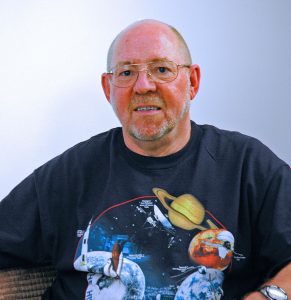
The author: Dennis Ashton is a Fellow of the Royal Astronomical Society and a Wonderdome presenter.
In 2024, Dennis received the Special Contribution award from the British Association of Planetaria.
Wonderdome now has 14 presenters, making us the largest – and best – mobile planetarium organisation in the UK.
Would you like more Astronomy news?
Do you want to hear about our upcoming public events?
Follow Wonderdome Portable Planetarium on Twitter / X and Facebook.
Or you can go at our website wonderdome.co.uk.

